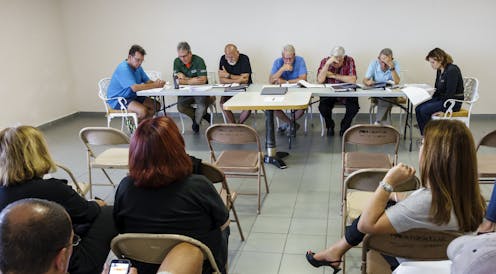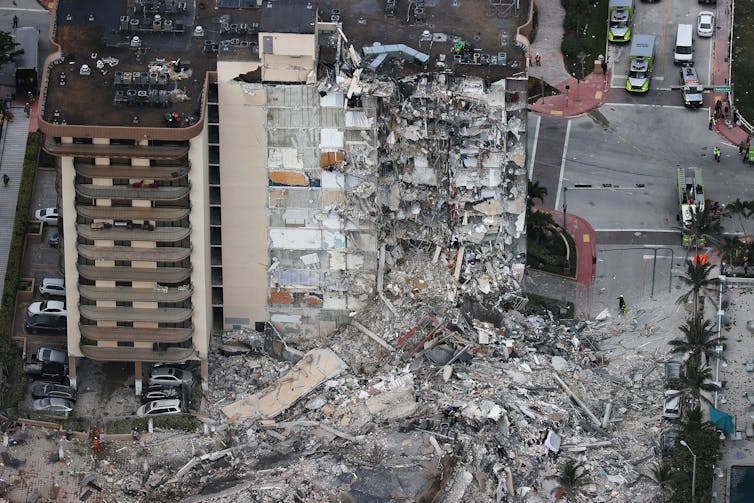Condo board leaders can help prevent the next Surfside-style disaster by setting aside more money
An expert on condo management explains why associations should commission new studies that determine how much money they need to set aside for repairs every three to five years.

When people buy homes, they often focus on appearances – what realtors call “curb appeal.” When it comes to buying condominiums – privately owned individual units in a large property complex – I believe that Americans need to take other factors into consideration.
Officials determined that a total of 98 people died in the June 24, 2021, collapse in Surfside, Florida, of the Champlain Towers South building. The calamity displaced dozens more. Hundreds of additional condo residents in the Miami area have since been forced to evacuate their high-rise homes as authorities have become more concerned about structural dangers and dangerously deferred maintenance.
I belong to a 40-unit condominium association where everyone resides in one of five Louisville, Kentucky, apartment buildings constructed in 1943 and 1954. In addition to serving as my association’s president for the past three decades, I have taught more than 700 board member and condo owners leadership classes and wrote a guidebook about the condo governing process.
To me, what happened when a Florida residential tower collapsed in the middle of the night illustrates how the pitfalls of condominium ownership and management can literally kill people.
Figuring out what repairs will cost
Some 30 million Americans live in condo buildings, the Community Associations Institute estimates.
These properties are built initially by real estate developers and then later managed by homeowners’ associations, which in turn are led by all-volunteer boards. The members of those boards are residents elected by their fellow owners and need not have any construction, finance or property management expertise. The associations collect money from all owners, with monthly fees that typically range from US$200 to $600.
These funds pay for roof replacements, insurance, some utilities and outside maintenance. Some well-managed associations set money aside each month in a reserve account to cover future big expenses or an emergency.
There are rule-of-thumb guidelines, such as setting aside 10% or 25% of the annual budget.
But, like all rules of thumb, this one can be misleading.
Instead, I recommend that associations hire a professional and independent consultant to develop a funding plan based on a detailed analysis of their properties. Known as a “reserve study,” this document can help boards decide how much money to set aside each year.
These studies estimate a condo association’s funding needs for major repair and replacement expenses for everything from roofs to plumbing infrastructure to swimming pools and parking garages.
Typically, reserve studies include annual estimates for expenditures. Most also include projections for the next 30 years, plus summaries of various options for paying for those repairs, replacements and upgrades.
Starting when the developer turns the property over to the condo association, I recommend that the first board of directors hire an engineer for a structural and mechanical analysis. If major concerns about the building arise during that process, it can sometimes help resolve construction disputes with the developer – or become the basis for litigation. The initial board should also commission a reserve study to assess long-range cash flow needs.
A structural engineering report can assess the physical condition of buildings and must be done by a trained engineer, who may open up walls and inspect the condition of plumbing, wiring and other systems.
The Surfside tower pancaked to the ground three years after an engineering report called for a deeper analysis of how much it would cost to keep residents safe. The report was commissioned for a county-required certification once condo buildings reach the 40-year mark, and construction on the Champlain Towers South was completed in 1981. Among other things, the report called for fixing or replacing damaged concrete and rebar after years of persistent water leaks.
Reserve studies are typically updated every three to five years. There is no consensus about how often to engage a structural engineer, however.

Predicting cash shortfalls
Whether homeowners in these arrangements live in multi-story-buildings, townhouses or single-family homes, their associations’ reserves may be insufficient to cover the cost of an urgent need. High-rise condos have shared infrastructure, like roofs, plumbing systems, wiring and the actual buildings.
Most likely, very few condo buildings are on the verge of a literal collapse. But many condo associations are short on cash for much-needed renovation and maintenance.
This kind of deficit often accumulates over time. But I’ve often seen it begin when real estate developers initially set monthly maintenance fees at unrealistically low levels because that makes those homes easier to sell.
Decades later, the all-volunteer board of directors has to deal with the consequences when its members must persuade their neighbors to pay higher monthly fees or one-time special assessments to cover the cost of urgently needed major renovations.
In April 2021, two months before the deadly collapse, the Champlain Towers South condo association approved a $15 million assessment to pay for – clearly – much-needed repairs. Examples of this work, spelled out in the 2018 report, included rebuilding and waterproofing balconies, replacing all the windows and thoroughly rebuilding the swimming pool and garage.
Owners were supposed to pay anywhere from $80,190 for one-bedroom units to $336,135 for a four-bedroom penthouse, either right away or through a monthly fee for the next 15 years.
Not everyone can afford to make such large payments. Owners may end up losing their homes through foreclosure when they face huge assessments.
Heeding warning signs
In 2020, California started requiring periodic condo inspections, including the kind that can spot structural damage. This change responded to an alarming disaster: In 2015, a balcony collapsed on a fourth-floor apartment building in Berkeley that was only nine years old. Six people died, and seven were injured.
The Surfside collapse was taped on a nighttime surveillance camera and watched by countless people worldwide. State lawmakers in Florida and elsewhere are calling for new measures that would tighten the regulation over condo homeowner associations in an effort to prevent similar tragedies.
David B. Haber, a Florida real estate lawyer, is calling for new federal and state loan programs to make it easier for cash-strapped condo owners to foot the bill for big special assessments required for health and safety reasons.
I would advise all condo buyers to make sure that an association overseeing a property that has caught your eye is good at long-range planning. Try to figure out if the association’s board is paying attention to whether the structures it maintains, including plumbing and electric systems, are sound, and whether the property’s financial reserves match the levels recommended by independent professionals.
And I would encourage all condo board members to communicate often and openly with all their fellow owners. This approach will help them earn and maintain the trust of their neighbors as they make the case for raising monthly fees and moving forward with often expensive, inconvenient but essential repairs and renovations.
Patrick Hohman receives funding for his University Course development from a 501c3 called Shared Expense Housing Education Initiative. (www.SEHEI.org) This 501c3 was formed in 2018 by civic-improvement-minded members of a small Episcopal church in Louisville, Kentucky, St. Andrews, where Patrick is a member.
Read These Next
Columbia president holds her own under congressional grilling over campus antisemitism that felled t
A rhetoric scholar says Columbia University President Nemat Shafik fared much better than her predecessors…
5 years after the Mueller report into Russian meddling in the 2016 US election on behalf of Trump: 4
What Trump knew about alleged Russian meddling in the 2016 presidential election remains an open question…
Cities with Black women police chiefs had less street violence during 2020’s Black Lives Matter prot
The type of life and professional experience a police chief has can influence how their departments…



